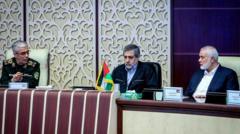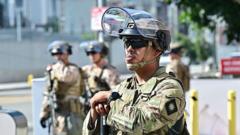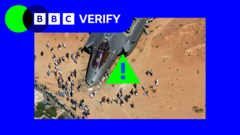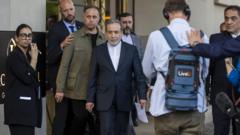On June 21, 2025, President Trump authorized U.S. airstrikes on three Iranian nuclear sites, marking a decisive entry into the ongoing Israel-Iran conflict. The bombings, aimed primarily at the heavily fortified Fordo facility, raise concerns of severe retaliation from Iran, heightening fears of a broader war in the Middle East.
U.S. Military Strikes Intensify Tensions in Iran-Israel Conflict

U.S. Military Strikes Intensify Tensions in Iran-Israel Conflict
In a significant escalation of military engagement, the United States targets key Iranian nuclear facilities alongside Israel's ongoing strikes, propelling the region into a volatile new chapter of conflict.
The ongoing conflict between Israel and Iran escalated dramatically on June 21, 2025, when President Trump announced U.S. military strikes targeting three critical Iranian nuclear sites. This announcement follows Israel's earlier attacks aimed at curtailing Iran's nuclear capabilities, intensifying the militarized atmosphere in the region.
In a tweet, President Trump revealed that U.S. warplanes had successfully struck Iranian facilities, including the crucial Fordo underground site. This facility is vital to Iran's uranium enrichment efforts and is considered among the most fortified in the country. Trump stated, “All planes are now outside of Iran airspace” after executing the mission.
Iranian officials indicated that the airstrikes occurred around 2:30 a.m. local time in Iran, with Iran’s military having previously issued warnings about potential repercussions following the U.S. involvement. As the situation develops, analysts speculate that Iran might respond by accelerating its nuclear program or launching retaliatory strikes against U.S. allies in the Middle East.
The strikes bring a definitive shift in American military policy after weeks of President Trump's wavering stance on intervention. He previously expressed skepticism regarding prolonged military engagements overseas but ultimately sided with Israel's call for action in a deeply divided geopolitical landscape.
Reports suggest that additional U.S. military assets, including F-22 and F-16 fighter jets, have been deployed to support the air operations. Meanwhile, tensions mount across the region, with neighboring countries expressing concern over the widening conflict.
Reflecting on the broader implications, regional experts fear that the strikes could prompt Iran to activate its network of proxy forces throughout the Middle East, potentially impacting oil supplies and international trade routes. The U.S. Secretary of State Marco Rubio had a contrasting message just days before, asserting that protecting U.S. forces remained paramount, however, Trump's recent actions indicate a pivot toward direct military involvement.
Israeli Prime Minister Benjamin Netanyahu has characterized these operations against Iran as a necessary maneuver to prevent an existential threat posed by a nuclear-capable Iran. As fighting intensifies, both sides brace for escalated military engagements, with Iraq and other neighboring states caught in the middle of a conflict that threatens to spiral beyond control.
The unfolding situation remains fluid, with many now watching for Iran's subsequent responses, as international diplomatic efforts appear increasingly futile. The stakes have grown exponentially as the U.S. and Israel position themselves for a potential clash that could reshape the Middle East’s security dynamics.























